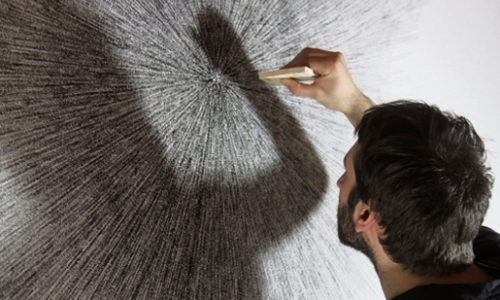Ahmad Angawi and Idris Khan help reframe the British Museum’s Islamic art collection
When the management of the British Museum decided to shift its collection of Islamic art into a new gallery, they selected two artists — Ahmad Angawi from Saudi Arabia and Idris Khan from the UK — to create site-specific works. The pair were selected for their ability to assimilate their heritage in a contemporary way — a blend that is ideal for the new gallery space, which reframes the museum’s Islamic art collection, presenting a fusion of cultures in the Islamic world through ancient, medieval and modern times.
Both have used the physical space of the new Albukhary Foundation Gallery, which opened October 18, to display their work in a dynamic way. Angawi has created five Mangour screens to cover windows in the gallery, while 21 of Khan’s paintings cover one of the walls. “The screens complete the atmosphere of the gallery, bringing the spirit of the Hijaz, the heartland of Islam, to the gallery,” said Venetia Porter, assistant keeper, Department of the Middle East at the British Museum.
Angawi’s five screens are made from walnut wood, using traditional Hijazi craft with modern manufacturing techniques. Samples for the windows were created by craftsmen in Jeddah and finished by craftsmen in London. Two of the five screens are placed on facing windows. “It feels like they almost have a dialogue with one another, so the idea of the heart and mind in dialogue came to my mind immediately,” Angawi explained.
“When you do traditional craft you connect your body, mind and soul into an object. I wanted (to convey) the way that when you look at those screens, you also look with your mind and you see the techniques with your heart and you see the passion and connection they represent. “I really wanted to work with craftsmen here in London,” he continued. “I don’t like the idea of cutting something from my culture and pasting it in in London. I wanted to make an integration of cultures between London and Makkah.” For Porter, this integration of tradition and modernity was crucial.
“Right from the beginning, we were very clear about wanting to bring the contemporary into it,” she said. “I feel really strongly that when you look at this region … you need to be looking at it as a continuum. When you look at it all as material culture, it’s actually very easy to incorporate contemporary in with the ‘old’. We’ve done it throughout the gallery.” She was first able to articulate this philosophy during the museum’s “Hajj: Journey to the Heart of Islam” exhibition in 2012, which drew an unprecedented number of Muslim visitors to the museum.
That exhibition ended with Khan’s “You and Only You,” in which the artist used words to represent the footsteps of a pilgrim, in an attempt to capture the energy of a mass of people circling the Kaaba. Porter — and her patrons group, who support acquisitions of material at the museum — were keen to involve Khan in the new site-specific gallery work. “We talked about a number of artists and the one we decided upon immediately was Idris, because of that past relationship, because the work that he does is so interesting, and because of the way that he thinks about his Muslim heritage,” Porter said. The resulting commission is Khan’s “21 Stones,” — a collection of 21 stamp paintings. “I turn poems, or passages of writing, into rubber stamps and they become wood blocks basically.
Then I paint with them with oil, usually on either an aluminum surface or a paper surface,” Khan explained. He began his stamp paintings in 2010, a turning point in his work. He had trained as a photographer, but felt that his photographs always looked like paintings. “2010 it was quite a tricky year for my wife and myself,” he said. “My mother died — and she was young, 59 — and my wife lost the baby very late in pregnancy and it was really sort of a tough year in terms of grief. “It was at that point that I (decided) to create drawings with words and stamping. In the studio, I’d get a piece of paper set up and I’d come in, write these sentences, make them into rubber stamps and then start stamping the paper.
It was ridding myself of the grief that I was going through at the time in a very cathartic way,” he continued. “When I started (this process), the words were important. But then they became less important — an abstraction of those words. As they become artworks, they lose that content and become something else, something you can’t quite… It’s intangible.” With “21 Stones,” Khan tried to convey the moment of release for a Hajj pilgrim performing the stoning of the Jamarat at Mina (when pilgrims throw 21 stones at the wall).
“The idea itself is a very beautiful thing,” he said. ”One takes a stone, stands in front of a wall representing the devil and wishes away any bad feelings or thoughts or future or past — whatever the pilgrim wants to think about — and that emotional release of a stone hitting the wall and becoming words was such a beautiful thing in my mind. So I wanted to try and see if I could make an artwork that had that kind of impact.” Unusually, his and Khan’s work will be on display in the gallery for the next year. “Normally we’d have to change it every six months, but we’re so excited by this that we can’t bear the thought of it only being up for six months,” Porter said.
Related Posts

